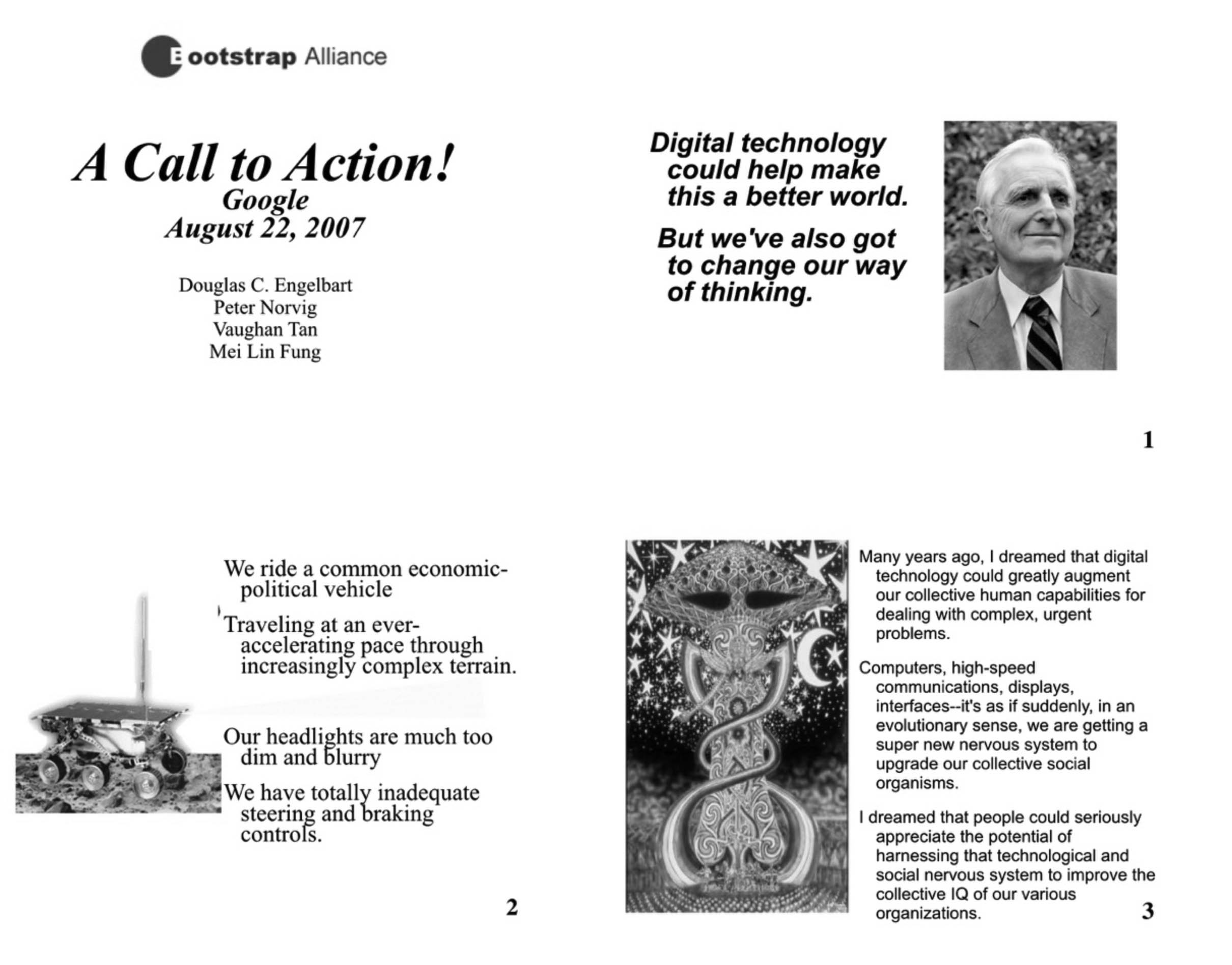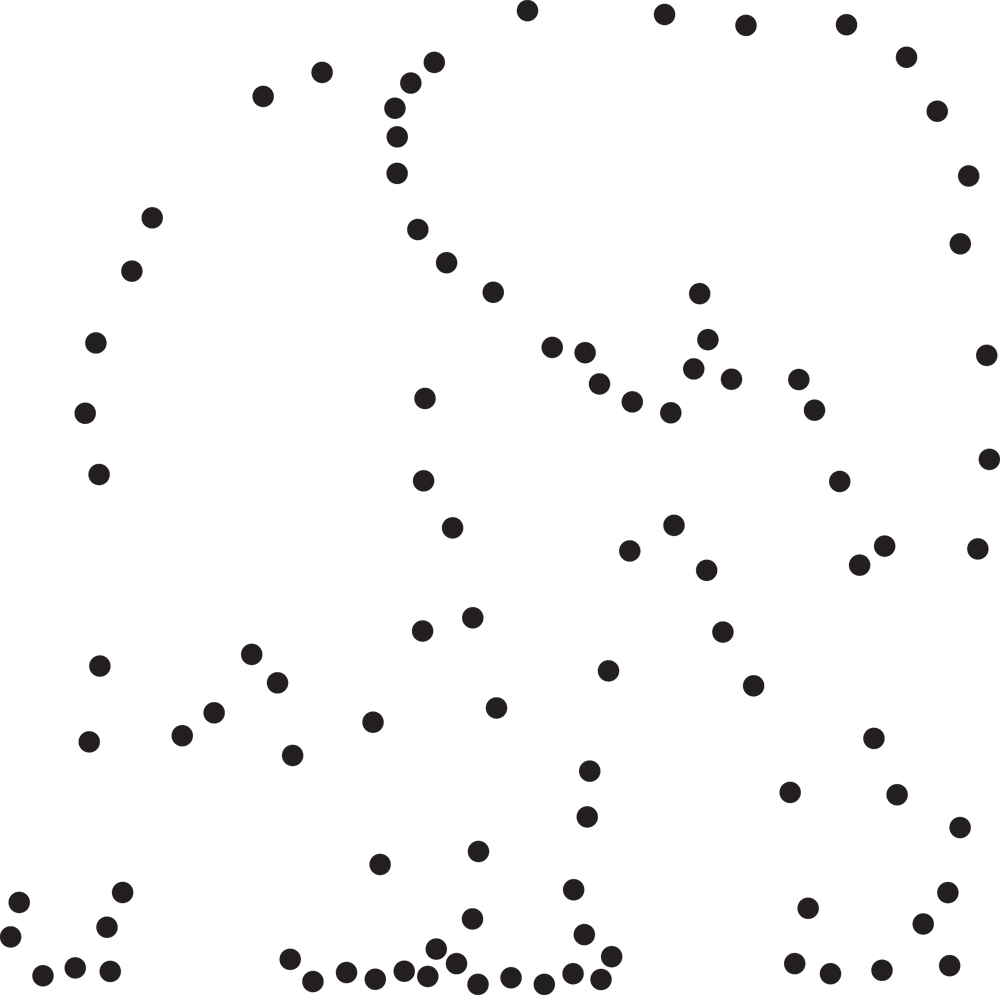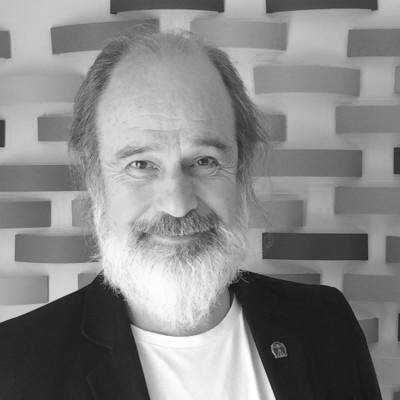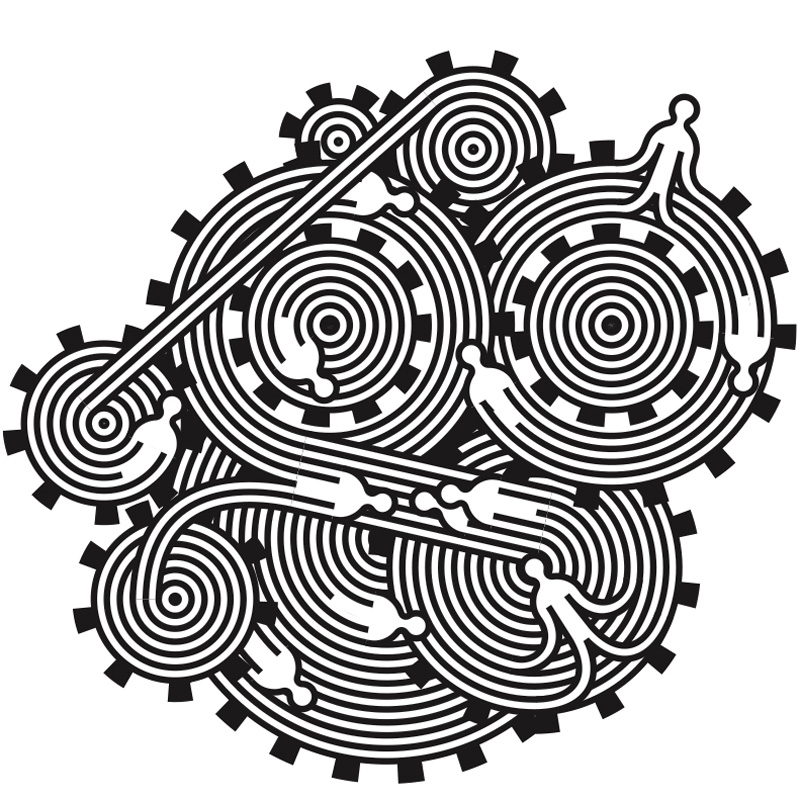STORIES
Contents
Federation through Stories
Envisioning the paradigm
The invisible elephant
You have noticed that in knowledge federation we like to use metaphors to describe the emerging paradigm and its various elements? There are reasons for that. George Lakoff found out (to name one of them), that our thinking is largely in terms of metaphors – that we use physical metaphors for abstract or high-level concepts. So how much more do we need them when we are speaking about things that are yet to emerge, things that nobody has yet seen?
So as we did in Federation through Images, here too we begin with a metaphorical image. It's the invisible elephant. We use this metaphor for the whole big thing, the entire large Renaissance-like paradigm that, we promised you, wants to emerge as soon as we begin to 'connect the dots'. And so that's the core of our task – to facilitate this development that is so valuable and so urgent now, of our ability to 'connect the dots'.
Vignettes
How to lift up an idea of a giant from undeserved anonymity
We tell vignettes – engaging, lively, catchy, sticky... real-life people and situation stories, to distill the core ideas of the most daring thinkers from the vocabulary of their field, and to give them the power of impact. We then show how to join the vignettes together into threads, and threads into patterns and patterns into a gestalt – an overarching view of our situation, which shows how the situation may (need to) be handled.
While it is the ideas that lead to the gestalt, it is the gestalt that gives the ideas their relevance, and their deeper reason for existence.
The incredible history of Doug
The 21st century printing press
Of course it's the Web – but...
The printing press is a suitable metaphor and a point of departure for us, because of its central role in the emergence of the last big societal paradigm shift. Indeed, Gutenberg's has often been credited for the spreading of knowledge that resulted in the Enlightenment, and all the other related transformations. What might play a similar role today? The story told next will highlight some of the main points in a palpable and vivid way.
Engelbart's epiphany
Having decided, as a novice engineer in December of 1950, to direct his career so as to maximize its benefits to the mankind, Douglas Engelbart thought intensely for three months about the best way to do that. Then he had an epiphany.
On a convention of computer professionals in 1968 Engelbart and his SRI-based lab demonstrated the computer technology we are using today – computers linked together into a network, people interacting with computers via video terminals and a mouse and windows – and through them with one another.
In the 1990s it was finally understood, or in any case some people understood, that it was not Steve Jobs and Bill Gates who invented the technology, or even the XEROS PARC from which they took it. Engelbart received all imaginable honors that an inventor can receive. Yet he made it clear, and everyone around him knew, that he felt celebrated for a wrong reason. And that the gist of his vision had not yet been understood, or put to use. "Engelbart's unfinished revolution" was coined as the theme for the 1998 Stanford University celebration of his Demo. And it stuck.
The man whose ideas created "the revolution in the Valley" passed away in 2013 – feeling he had failed.
Engelbart's unfinished revolution
What was it that Engelbart saw in his vision, and pursued so passionately throughout his long career? What was it that people around him could not see? We'll answer by telling you a story, about one of the many events where Engelbart was celebrated, and when his vision was in the spotlight – a videotaped panel that was organized for Doug at Google in 2007. This will give us an opportunity to explain the vision – if not with Doug's own words – then with his own Powerpoint slides.
It seems best to introduce it by another anecdote, and – if not by his own words, then at least by his own Powerpoint slides. Here they are.

Around 2007 time it became clear that his long career was coming to an end. The title "A Call to Action!" (with the exclamation mark!) he choose for his presentation was obviously intended make it clear that what he wanted to give to Google, and to the world, was a direction and a call to pursue it.
The first slides points to a large and unfulfilled opportunity that is immanent in digital technology. To realize it, we need to change our way of thinking.
The second slide talks about a 'vehicle' we are riding in. This image is so close to our bus with candle headlights, the Modernity ideogram that was discussed at length in Federation through Images, that we now only need to point to it for interpretation. OK, yes, there's also more in Doug's slide, he's talking about "the steering and braking controls". We'll come back to that in a moment.
The third slide was intended to explain the big fat point, what really Doug's vision was about. But let's hold back a moment, let's not rush with the explanation.
If we should now tell you the solution to this riddle in our own words, we risk repeating what happened with Doug's vision so many times before. So no, let's do this differently. Let us stay with the second slide for another moment. Let us first materialize at least a little bit of the invisible elephant – and see how the second slide fits in.
Materializing the invisible elephant
Here is how we offer to characterize the situation just described.
Every time Engelbart was present in a room talking, or being celebrated, there was also an elephant in the room. Imagine a huge animal, in the midst of a large university auditorium – should this not be a first-rate sensation? But alas – the elephant was invisible; or better said – nobody saw it except Doug!
We use this metaphor to point to the nature of Engelbart's situation – which was indeed (we shall see examples in a moment) also the situation of so many of the last century visionary thinkers. Think of an elephant in the room five centuries ago, not today. Nobody in the room has see one in real life. And even Doug, and any other visionary, sees the elephant from a specific angle of looking, as determined by his field of interest. And so they talk about 'the fan' or 'the hose' or 'the rope' – when what they rally mean is the ears and the trunk and the tail of the big animal.
And so before we tell you the punchline, the big point of The Incredible History of Doug – follow us through a detour. We want to materialize – well, not of course the whole elephant (even in this whole website we are only materializing parts), but enough of it so that you may begin to connect the dots and begin to get the sense of the elephant's weight and size.
Before we begin, let's clarify a subtle point we want to point to with this metaphor. It has been said that a visionary is a person who looks at what we all are looking at, and sees something entirely different than what we see. Yet even a visionary sees through the binocular of his culture. And when he attempts to describe what he sees, he dilutes his vision still further, by trying to render it in words that other people can grasp (although it cannot really be described in that way). Our point is that the most interesting and relevant question here is not what any of our visionaries "really" saw (even they couldn't tell us that). What really interests us above all is the nature of 'the elephant' itself! So it's a clear view of that really big and mighty thing that we are after.
Democracy for the third millennium
What we shall see next is roughly the same part of the invisible elephant that Engelbart saw – but from an entirely different angle. We'll be talking about democracy – but you can already anticipate that we are not departing from our theme. Doug's second slide was obviously talking about the way in which we control – or don't control our journey into the future and our destiny.
A whole new nightmare scenario
In the old ( and still so stubbornly dominant traditional order of things) democracy is what it is: free elections, free press... As long as we have that, we assume, we have democracy. We the people are in control. The nightmare scenario in this order of things is a dictatorship, where a dictator takes from the people those affordances of control and tokens of freedom.
But there is another nightmare scenario, much worse indeed than the one just mentioned. And that is what Doug was pointing to in his second slide at Google. It is the scenario where nobody has control! Simply because our system or systems don't have the structure in which control is at all possible (or metaphorically, because they lack suitable "headlights" and "steering and braking"). A dictator may come to his senses. His more reasonable son may succeed him. But if the system is not controllable by design – well then we really have a problem!
The cybernetic view
A scientific reader may have noticed that Doug's seemingly innocent metaphor in Slide 2 also has a technical-scientific interpretation. In cybernetics, which is a scientific study of (the relationship between information and) control, "feedback and control" that are household terms. Just as the bus must have functioning headlights and steering and breaking controls, so must any system have suitable feedback (information inflow, and use) and control (a way to apply the incoming information to correct its course, or more generally behavior) – if it is to be controllable.
In just a moment we'll be connecting the dots from that side of our puzzle – What is it that the people in cybernetics saw about the nature of our 'headlights' and 'steering and braking controls'? The idea is to make steps toward the kind of democracy, that is, toward the kind of 'headlights' and 'steering and braking controls' that we the people may need, if we (as civilization, and as species) want to be around for another millennium. We'll introduce the cybernetic point of view, however, by talking about a man whose insight inspired (in part, at least) both Doug and the cyberneticians!
What the scientists must do next
Vannevar Bush was the giant who most vividly and from an authoritative position pointed to the urgent need for (what we are calling) knowledge federation – already in 1945!
A pre-WW2 pioneer of computing machinery, and professor and dean at the MIT, During the war Bush served as the leader of the entire US scientific effort – supervising about 6000 leading scientists, and assuring that the Free World is a step ahead in developing all imaginable weaponry including The Bomb. And so in 1945, the war just barely being finished, Bush wrote an article titled "As We May Think", where the tone is "OK, we've won the great war. But one other problem still remains to which we scientists now need to give the highest priority – and that is to recreate what we do with knowledge after it's been published". He urged the scientists to focus on developing suitable technology and processes.
Engelbart heard him. He read Bush's article in 1947, as a young army recruit, in a Red Cross library in the Philippines, and it helped him 'see the light' a couple of years later. But Bush's article inspired in part also another development – and that's what we'll turn to next.
The science behind democracy
Norbert Wiener was recognized as a potential giant very early. After having studied mathematics, zoology and philosophy, he finally got his doctorate in mathematical logic from Harvard, at the tender age of 17! Then he went on to do seminal work in a number of fields, one of which was cybernetics.
Norbert Wiener mentions Bush in a just a touch convoluted yet for us most interesting and most relevant argument, in the last chapter of the first, 1948, edition of Cybernetics. The argument combines two points that are central here:
- Our communication, or feedback, or 'headlights' is broken, and urgently requires an update
- We cannot relegate our 'drive into the future' (daily choices and long-term evolution; the executive and legislative function...) to "the invisible hand" of the market. Suitable information must be created and put to use, if we should have the ability to steer a viable course.
Listen for a moment to Wiener's language:
The "homeostatic process" here is a "feedback mechanism inducing measures to keep a system continuing".There is a belief, current in many countries, which has been elevated to to the rank of an official article of faith in the United States, that free competition is itself a homeostatic process: that in a free market the individual selfishness of the bargainers... will result in the end in ...the greatest common good... unfortunately, the evidence, such as it is, is against this simple-minded theory.
Sustainability 101
How to steer a sustainable course
Having received his doctorate in astrophysics at the tender age of 22, from the University of Vienna, Erich Jantsch realized that it is here on Earth that his attention is needed. And so he was soon researching (for OECD in Paris), on what you might readily identify as the theme of "Engelbart's unfinished revolution" – the ways in which technology is being developed and used, in the context of the goal of steering a viable course into the future.
And so when The Club of Rome (global think tank organized to research the future prospects of mankind) had its first, inaugural meeting in Rome, in 1968, it was Jantsch who was given the honor to give the opening keynote. Naturally – because, isn't it clear, the completely new problems that the humanity may have or already had all had to do with the correct use, or misuse, of the new power that the technology has given us. The five people who ended up initiating The Club, all really smart people, had no difficulty realizing that it was not problems they should be focusing on, but the "problematique", i.e. the overall condition from which the problems arise, and which may enable or prevent their resolution.
While the longer story of Jantsch is most interesting, and also his deeper insights, we shall here only name a few steps in his thinking process following the Club of Rome meeting – because that is what we, above all, need from him at this moment.
Feedback
Text
Control
Text
Design for evolution
Text
Wiener's paradox
Academic publishing had no effect
Ronald Reagan is not presented here as one of the giants, but as a person who none the less can open up our eyes to the nature of our situation, and of the emerging paradigm, perhaps even a lot better than the words of the more visionary people may. In the 1980 – when Erich Jantsch passed away at the tender age of 51 (an obituary mentioned malnutrition as a possible cause...), having just issued two books about the "evolutionary paradigm" in science and in our understanding and handling of systems, Ronald Reagan became the 40th U.S. president on a clear agenda: We can only trust the market! The moment we begin to interfere with its perfect mechanisms, we are asking for trouble.
The point here is not whether he was right or wrong, but the lack of knowledge federation. The words of our giants just simply had no effect on how the votes were cast – and how the world ended up being steered!
What we have is a paradox
"As long as a problem is treated as a paradox, it can never be resolved,...". What we have is not a problem, it's a paradox! To see that, notice that Norbert Wiener etc.
In 2015 we presented an abstract and talk titled "Wiener's paradox – we can resolve it together" to the 59th conference of the International Society for the Systems Sciences. The point was.
The solution is bootstrapping
The alternative – we must BE the systems! Engelbart - bootstrapping. Jantsch - action! Our design epistemology...
Doug's last wish...
Dissolving the paradox
Engelbart is dead – long live Engelbart!
Well, this title is ad-hoc and probably completely awkward...
Less than two weeks after Douglas Engelbart passed away – on July 2, 2013 – his dream was coming true in an academic community. AND the place could not be more potentially impactful than it was! As the President of the ISSS, on the yearly conference of this largest organization of systems scientists, which was taking place in Haiphong, Vietnam, Alexander Laszlo initiated a self-organization toward collective intelligence.
He really had two pivotal ideas. One was to make the community intelligent. The other one was to make an intelligent system for coordinating change initiatives around the globe. (An extension of).
Alexander was practically born into this way of thinking and working. His father...
We came here to build a bridge
We came to Haiphong with the story about Jantsch and Engelbart; and with the proposal "We are here to build a bridge"...
And indeed – the bridge has been built! The two initiatives have federated their activities most beautifully!
Prototypes include LaSI SIG & PHD program, the SIL... And The Lighthouse project, among others.
The meaning of The Lighthouse (although it belongs really to prototypes, and to Applications): It breaks the spell of the Wiener's paradox. It creates a lighthouse, for the systems community, to attract stray ships to their harbor. It employs strategic - political thinking, systemic self-organization in a research community, and contemporary communication design, to create impactful messages about a single issue, and placing them into the orbit: CAN WE TRUST "THE MARKET"? or do we need systemic understanding and innovation and design?
The future of innovation
In a nutshell
How do you picture what Erick Jantsch foresaw as the design object of our time, and called "joint systems of society and technology"? We gave our design team what might be the challenge of our time – to make this design object palpable and clear to people. The above System ideogram is what they came up with.
We let this ideogram stand for this key challenge – to help people see themselves as parts of larger systems. To see how much those systems influence our lives. And to perceive those systems as our, that is human creations – and see that we can also re-create them!
Changing scales
Polyscopy as a methodology in knowledge creation and use has an interesting counterpart in systemic innovation as we are presenting it here. Yes, we have been focused so much on the details, that we completely neglected the big picture. But information – and also innovation, of course – exist on all levels of detail! Should we not make sure that the big picture is properly in place, that we have the right direction, or that the large system is properly functioning, before we start worrying about the details?
The next industrial revolution
So forget for a moment all that has been said here. This is not about the global issues, or about information technology. We are talking about something far larger and more fundamental. Think about "the systems in which we live and work", as Bela H. Banathy framed them. Imagine them as gigantic machines, which we are of course part of. Their function is to take our daily work as input, and produce socially useful output. Do they? How well are they constructed? Are they wasting our daily work, or even worse – are they using it against our best interests?
See
Our portfolio of prototypes
When these and other obvious questions are asked and reflected a bit upon, when we understand just how neglected these things are, how misfunctional or dysfunctional they have become, the possibility of a next-generation industrial revolution (of a revolutionary improvement in the effectiveness and efficiency of our work) through innovation becomes transparent. In the last century we invented the airplane, the refrigerator, the washing machine... In this century the inventions that most influence our lives will be on the much larger socio-technical level. Seeing this, one must become curious, and vitally interested, to see what next-generation inventions might be like? If we allow ourselves to recreate scientific collaboration and communication, journalism – and most importantly how those two interact and collaborate with one another... And then of course education, and our other institutions. Those questions are, as you might recall, taken up in Federation through Applications. Explore our portfolio of prototypes in Federation through Applications.
Our most interesting question
The following question might indeed be now the most interesting one (when the above is properly ingested and digested): How is it possible that Engelbart and Jantsch and Wiener and all the others were not heard and understood until today? And regardless of our giants, and even more interestingly – what has hindered us from taking up systemic innovation all this time? We offer a prototype answer inFederation through Conversations, in connection with The Paradigm Strategy poster. This is where the further techniques, that build on the vignette, are applied and shown. Most importantly, however, we weave together the insight of sociologists, cognitive scientists, anthropologists, historians... to understand how we got here; and what it is that we need to do to go further. MOST interesting indeed – but let's look at it there.
See also
Our evangelizing prototypes for systemic innovation.
The emerging societal paradigm is often seen as a result of some specific change, for example to "the spiritual outlook on life", or to "systemic thinking". A down-on-earth, life-changing insight can, however, more easily be reached by observing the stupendous inadequacy of our various institutions and other systems, and understanding it as a consequence of our present values and way of looking at the world. The "evangelizing prototypes" are real-life histories and sometimes fictional stories, whose purpose is to bring this large insight or gestalt across. They point to uncommonly large possibilities for improving our condition by improving the systems. A good place to begin may be the blog post Ode to Self-Organization – Part One, which is a finctional story about how we got sustainable or how we built a better world, written from a point in distant future. Toward a Scientific Understanding and Treatment of Problems is an argument for the systemic approach that uses the metaphor of scientific medicine (which cures the unpleasant symptoms by relying on its understanding of the underlying anatomy and physiology) to point to an analogous approach to our societal ills. The Systemic Innovation Positively recording of a half-hour lecture points to some larger-than-life benefits that may result. The already mentioned introductory part (and Vision Quest) of The Game-Changing Game is a different summary of those benefits. The blog post Information Age Coming of Age is the history of the creation and presentation (at the Bay Area Future Salon) of The Game-Changing Game, which involves Doug Engelbart, Bill and Roberta English and some other key people from the Engelbart's intimate community.
Our evangelizing prototypes for knowledge federation.
The wastefulness and mis-evolution of our financial system is of course notorious. Yet perhaps even more spectacular examples of mis-evolution, and far more readily accessible possibilities for contribution through improvement, may be found in our own system – knowledge-work in general, and academic research, communication and education in particular. (One might say that the bankers are doing a good job making money for the people who have money...) That is what these evangelizing prototypes for knowledge federation are intended to show. On several occasions we began by asking the audience to imagine meeting a fairy and being approached by (the academic variant of) the usual question "Make a wish – for the largest contribution to human knowledge you may be able to imagine!" What would you wish for? We then asked the audience to think about the global knowledge work as a mechanism or algorithm; and to imagine what sort of contribution to knowledge a significant improvement to this algorithm would be. We then re-told the story about the post-war sociology, as told by Pierre Bourdieu, to show that even enormously large, orders-of-magnitude improvements are possible! Hear the beginning of our 2009 evangelizing talk at the Trinity College, Dublin, or read (a milder version) at the beginning of this article.
Knowledge Work Has a Flat Tire is a springboard story we told was the beginning of one of our two 2011 Knowledge Federation introductory talks to Stanford University, Silicon Valley and the world of innovation (see the blog post Knowledge Federation – an Enabler of Systemic Innovation, and the article linked therein). Eight Vignettes to Evangelize a Paradigm is a collection of such stories.
More about Engelbart
Bring to mind again the image of Galilei in house prison... It is most fascinating to observe how even most useful and natural ideas, when they challenge the prevailing paradigm, are ignored or resisted by even the best among us. The Google doc Completing Engelbart's Unfinished Revolution, is our recent proposal to some of the leaders of Stanford University and Google (who knew us and about us from before). Part of the story is about how Doug Engelbart's larger-than-life message, and "call to action" were outright ignored at the presentation of Doug at Google in 2007. And if you can read it between the lines, you'll in it yet another interesting story – showing the inability of the current leaders to allocate the time and attention needed for understanding the emerging paradigm; and pointing to a large opportunity for new, more courageous and more visionary leaders to take the lead.
The story of Knowledge Federation
See Knowledge Federation History.
See our 2016 presentation The Collective Mind Paradigm and Knowledge Federation: Completing Doug Engelbart's Unfinished Revolution which was delivered online to the Russian Metaversity Project (an innovative educational project of its own right...) – where we introduced Engelbart, the core of his vision and his "unfinished revolution", and then outlined the history of Knowledge Federation and some of our core prototypes, as strategic moves to complete the revolution.









